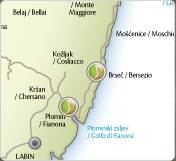
- Sečovlje Salt Pans - Dragonja River Valley
- Sv. Peter - Nova vas - Padna
- Pomjan - Nature Park: Karst Edge - Socerb
- Črni Kal - Osp - Kubed
- Momjan - Grožnjan - Pietrapelosa - Mirna
- Baštija - Kostanjica - Parenzana
- Oprtalj - Završje - Livade - Zrenj
- Istarske toplice - Motovun Forest - Višnjan
- Cave Mramornica - Feštini Kingdom - Cave Baredine
- Lim Bay - Kloštar - Kontija - Dvigrad
- Kanfanar - Bale - Palud - Vodnjan - Brijuni - Fažana
- Svetvinčenat - Tinjan - Pićan - Gračišće
- Belaj - Šumber - Kožljak - Paz
- Čepićko Field - Kršan - Boljun Castle - Lupoglav
- Plomin - Kvarner Gulf - Brseč
- Nature park Učka - Mošćenice
Plomin - Kvarner Gulf - Brseč
Plomin
In the 2nd millennium BC this hill-fort settlement was inhabited by the Liburnians, ancient seafarers and pirates. The arrival of the Romans brings battles for supremacy, so life moves to Plomin Bay. Owing to the great importance of Plomin, Roman Flanona, Kvarner acquires the name Sinus Flanaticus. Under the Roman influence, the population of that area, as well as entire Istria, accepts Roman deities, and from that time dates the relief of Silvanus, the pagan god of woods, today standing on St. George's Church.
After the fall of the Roman Empire, Plomin came under the rule of Ostrogoths, Byzantium and Lombards. In the Middle Ages, for safety reasons, the inhabitants once again moved to the site of the prehistoric hill-fort and today's Plomin. With the arrival of the Franks in the 8th c. feudalism is introduced, and Istria is permanently settled with Croats. In the 13th c. Plomin falls under the rule of the Patriarchs of Aquileia, and in the 15th c. under Venetian rule. It then becomes the most exposed Venetian stronghold on the eastern coast of Istria and the site of many attacks, which was severely damaged at the end of the 16th c. under Uskok attacks. After the fall of Venice in the 18th c., Plomin came under French and then Austrian rulers. World War I brought the Italian occupation, whereas during World War II it was occupied by the Germans.
The attractions in the old town display Plomin's rich history: remains of walls and fortifications built between the 12th - 14th cc., and then later from the 16th - 17th cc., as well as many buildings with preserved Renaissance and Baroque features, Municipal Loggia and charming little streets. The Church of St. George the Elder is from the 11th c. with the Late Antique relief of the god Silvanus and famous Glagolitic monument – the Plomin Tablet (Plominski natpis). Next to its stands the preserved Romanesque belfry.
The Parish Church of the Blessed Virgin Mary dates from the 15th c., with Gothic crucifix, stone custodia with Glagolitic inscription, wooded statues of saints and altar from the 17th c.
Напечатай страницу Отправь другу
















